Planetary Atmospheres Minor Species Sensor (PAMSS)
PI: Robert Peale, Josh Colwell (Co-I), University of Central Florida
PI: Robert Peale, Josh Colwell (Co-I), University of Central Florida

- TA06 Human Health, Life Support and Habitation Systems
- TA08 Science Instruments, Observations and Sensor Systems
- TA13 Ground and Launch Systems Processing
Trace gases can have a large impact on chemical reactions that control larger abundances of important atmospheric gases, such as pollutants and greenhouse gases. Trace gases can indicate for geologic and biologic activities. Knowledge of the presence, concentration, and spatial distribution is important on other planets as well as on Earth. A problem is that current methods of high sensitivity trace gases must interrogate over a range of altitudes and areas to obtain sufficient signal, and they are unable to quantify local concentrations and rapid spatial variations. An opportunity is PAMSS, the first mid-infrared intracavity laser absorption spectrometer. PAMSS achieves tens of kilometer effective optical path lengths in a small, light package with low power requirements.
The TRL4 prototype has demonstrated sensitivity to molecular absorption coefficients as small as 1 x 10^-5 cm^-1, which can correspond to a mixing ratios as small as 30 ppbv at 1 atm pressure. This recent achievement is by no means a fundamental limit, with at least two orders improvement anticipated. We plan to fly PAMSS on a balloon to demonstrate autonomous operation and trace gas sensing over a large range of pressures, temperatures, and concentrations. Success will advance PAMMS to TRL6.
The resulting technology will be available for proposal for planetary mission instrumentation to detect trace species in the atmospheres of Mars, Venus, Titan, or giant planets. In addition the technology can be used for Earth atmosphere sensing as well as for detecting trace gases that may pose a health hazard to workers or a scientific contamination hazard to spacecraft instrumentation. The technology has many other applications, incl. sensing for explosives and medical breath analysis.
Technology Details
-
Selection DateAFO6 (Jun 2013)
-
Program StatusCompleted
- 2 Balloon
Development Team
-
PIRobert Peale
-
PI Organization
-
Co-IJosh Colwell
-
Co-I Organization
-
SponsorUniversity of Central Florida
-
More Information

